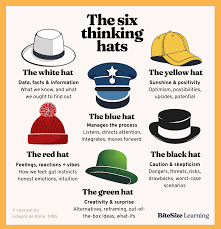This white paper explores the intersection of strategic thinking, Edward de Bono's Six Thinking Hats methodology, and the broader concept of lateral thinking. It will delve into the core principles of each, examine their applications in various domains, and discuss their potential synergies in enhancing decision-making and problem-solving processes.
Strategic Thinking, Six Thinking Hats, and Lateral Thinking: A Comprehensive White Paper
1. Introduction
This white paper explores the intersection of strategic thinking, Edward de Bono's Six Thinking Hats methodology, and the broader concept of lateral thinking. It will delve into the core principles of each, examine their applications in various domains, and discuss their potential synergies in enhancing decision-making and problem-solving processes.
2. Strategic Thinking: A Foundation for Success
Strategic thinking is a multifaceted cognitive process that involves:
- Defining long-term goals: Establishing clear and ambitious objectives aligned with an organization's mission and vision.
- Analyzing the environment: Identifying and assessing internal and external factors (e.g., SWOT analysis, PESTLE analysis) that can impact the organization's success.
- Developing and evaluating options: Exploring alternative courses of action, assessing their feasibility, and identifying potential risks and rewards.
- Formulating and implementing plans: Creating actionable strategies and roadmaps for achieving desired outcomes.
- Monitoring progress and adapting: Continuously tracking progress, evaluating results, and making necessary adjustments to plans based on new information and changing circumstances.
3. The Six Thinking Hats: A Structured Approach to Thinking
Developed by Edward de Bono, the Six Thinking Hats framework is a powerful tool for guiding group discussions and individual thought processes. It encourages parallel thinking by focusing on different aspects of a problem or decision sequentially:
- White Hat: Focuses on facts, data, and information.
- Questions: What information do we have? What information do we need? What are the known facts?
- Red Hat: Explores emotions, feelings, and intuitions.
- Questions: How do we feel about this? What are our gut reactions? What are the emotional implications?
- Black Hat: Emphasizes critical thinking, identifying potential risks and drawbacks.
- Questions: What are the potential problems? What are the weaknesses? What could go wrong?
- Yellow Hat: Focuses on the positive aspects, benefits, and opportunities.
- Questions: What are the advantages? What are the benefits? What are the potential gains?
- Green Hat: Encourages creativity and brainstorming, generating new ideas and solutions.
- Questions: What are some alternative approaches? What are some creative solutions? How can we think differently?
- Blue Hat: Oversees the thinking process, summarizing key points, and guiding the discussion.
- Questions: What have we learned? What are the next steps? How can we improve our thinking process?
4. Lateral Thinking: Breaking Free from Traditional Constraints
Lateral thinking, also pioneered by Edward de Bono, is a cognitive process that challenges conventional thinking patterns and encourages innovative solutions. It involves:
- Challenging assumptions: Questioning existing beliefs and exploring alternative perspectives.
- Seeking new perspectives: Looking at problems from different angles and considering unconventional approaches.
- Overcoming mental blocks: Identifying and overcoming cognitive biases that hinder creative thinking.
- Generating new ideas: Employing techniques such as brainstorming, mind mapping, and analogy to spark creativity.
5. Synergies Between Strategic Thinking, Six Thinking Hats, and Lateral Thinking
- Enhanced Strategic Decision-Making: The Six Thinking Hats can be effectively integrated into the strategic planning process. By systematically exploring different perspectives (facts, emotions, risks, benefits, creativity, and process), decision-makers can gain a more comprehensive understanding of the situation and make more informed choices.
- Improved Problem-Solving: The Six Thinking Hats framework can help teams overcome mental blocks and generate innovative solutions to complex problems. By encouraging parallel thinking and focusing on different aspects of the problem, teams can explore a wider range of possibilities.
- Increased Creativity and Innovation: Lateral thinking techniques can be used in conjunction with the Green Hat thinking to stimulate creativity and generate novel ideas. By challenging assumptions and exploring new perspectives, individuals and teams can develop more innovative and effective strategies.
6. Applications in Various Domains
The combined principles of strategic thinking, Six Thinking Hats, and lateral thinking can be applied across a wide range of domains, including:
- Business: Strategic planning, product development, innovation, marketing, and decision-making.
- Education: Curriculum development, teaching methodologies, problem-based learning, and creative thinking skills development.
- Healthcare: Medical diagnosis, treatment planning, research and development, and healthcare policy.
- Government: Policy development, decision-making, crisis management, and public service delivery.
- Personal Development: Goal setting, problem-solving, decision-making, and personal growth.
7. Conclusion
Strategic thinking, the Six Thinking Hats methodology, and lateral thinking are powerful tools for enhancing cognitive processes, improving decision-making, and fostering innovation. By integrating these concepts and applying them systematically, individuals and organizations can achieve greater success in addressing complex challenges and achieving their desired outcomes.
8. References
- De Bono, E. (1985). Six Thinking Hats. Little, Brown Book Group.
- De Bono, E. (1970). Lateral Thinking: A Textbook of Creative Thinking. Harper & Row.
- Mintzberg, H. (1994). The Rise and Fall of Strategic Planning. Prentice Hall.
- Porter, M. E. (1980). Competitive Strategy: Techniques for Analyzing Industries and Competitors. Free Press.
Note: This white paper provides a general overview. Further research and exploration are encouraged to deepen understanding and apply these concepts effectively in specific contexts.
Disclaimer: This white paper is for informational purposes only and does not constitute professional advice.
I hope this comprehensive white paper provides a valuable foundation for your understanding of strategic thinking, Six Thinking Hats, and lateral thinking. Contact keencomputer.com
